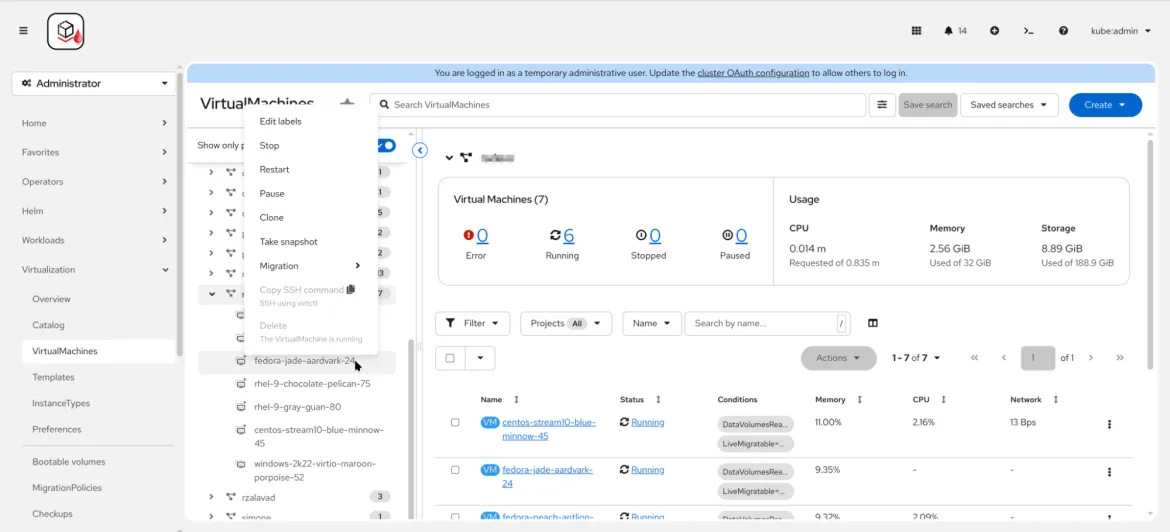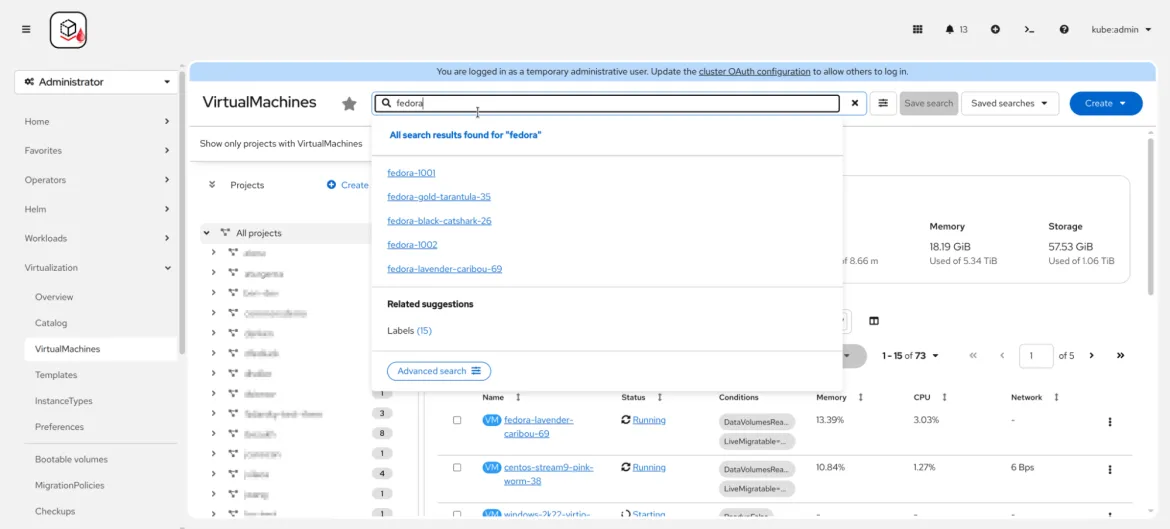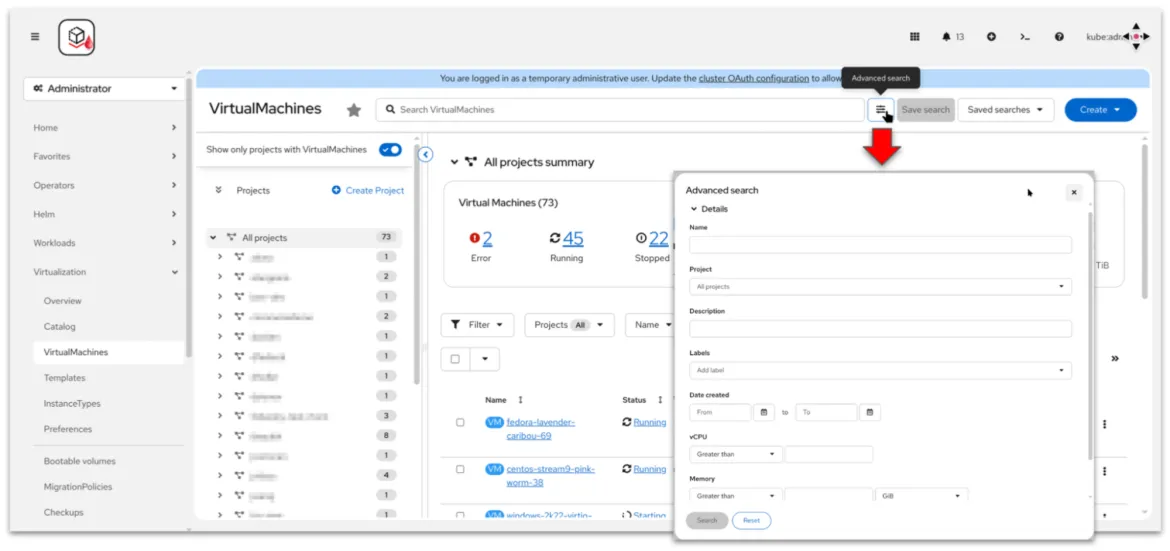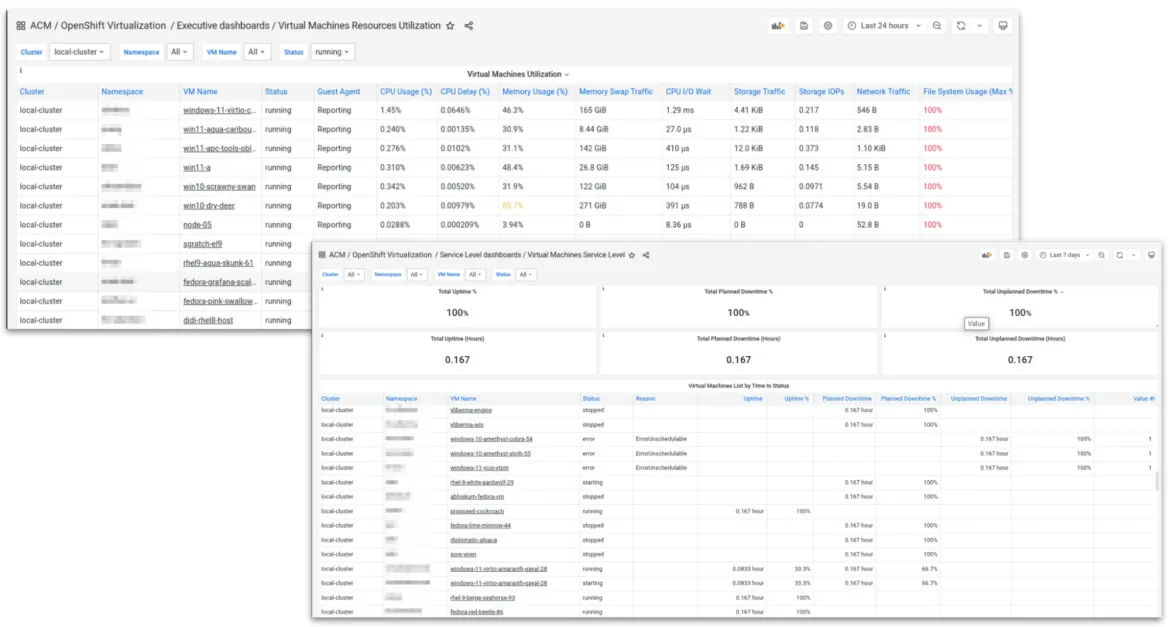Red Hat OpenShift Virtualization 4.19 is now generally available, expanding its capabilities to better meet the demands of hybrid cloud infrastructure, enhanced virtual machine (VM) management and global scale. With new platform availability, networking enhancements, live storage migration and an improved user experience, this release helps teams operate more efficiently, wherever they choose to run their workloads. Learn what's new in our OpenShift Virtualization 4.19 release.
Flexible infrastructure: Expanding your reach and control
Organizations are increasingly leveraging hybrid cloud strategies to gain agility, cost optimization and disaster recovery capabilities. Teams need flexible solutions that allow them to run their workloads on-premise, across public clouds or at the edge. Whether it's to avoid vendor lock-in, leverage services from different providers, or to meet different data and compliance requirements, you can now choose the optimal cloud platform to run your VMs on OpenShift. Red Hat OpenShift Virtualization is now available on all leading public cloud platforms and most recently has become available on the following solutions:
- Microsoft Azure: Red Hat OpenShift Virtualization on Azure Red Hat OpenShift is available as a public preview.
- Oracle Cloud Infrastructure: Red Hat OpenShift Virtualization is currently available on Oracle Cloud Infrastructure as a technology preview.
- Google Cloud: Red Hat OpenShift Virtualization on Red Hat OpenShift Dedicated on Google Cloud and Red Hat OpenShift Virtualization on self-managed Red Hat OpenShift on Google Cloud bare metal solution are both available as technology previews.
Additionally, Open Virtual Networking (OVN) Kubernetes localnet provides a better and more seamless user experience for connecting both pods and VMs directly to your underlying physical network. This enables both internal east-west cluster connectivity and access to services running outside the cluster.
IPv6 in technology preview
We're also introducing single-stack IPv6 as a technology preview for enhanced networking. This feature enables VMs to exclusively utilize IPv6 addresses for both the VM network and control plane, making it ideal for organizations that are transitioning to or primarily operating in IPv6 environments.
Data storage options
Red Hat also understands that data storage needs change constantly. Having the ability to dynamically migrate VM storage without downtime is critical for storage array lifecycle management, load balancing and overall storage optimization. Customers can now dynamically reconfigure their VMs' storage with storage live migration, allowing bulk migrations of VMs from one storage class to another. You can use this within a particular storage provider or array to move a VM to a different tier of storage, say from bronze to gold. During a storage lifecycle event, you can non-distruptively move all the workloads from your existing storage to a new storage array. The feature is currently available as a technology preview and will be generally available in a subsequent 4.19 z-stream.
Red Hat has also been working on improving performance for I/O intensive workloads like databases. This release enables multiple IOthreads for better I/O concurrency on fast storage. Databases can see up to a 30% improvement in throughput with reduced latency. You can read more about this new multiple IOthread feature from our performance and scale team.
Improved infrastructure optimization: Getting more from your resources
Efficient cluster operation depends on smart resource allocation, and that starts by understanding real-time usage. To help ensure optimal performance and avoid CPU resource bottlenecks, automatic VM workload balancing based on CPU resource utilization is now available as technology preview. This feature automatically distributes VM workloads based on actual CPU utilization across nodes. This intelligent workload placement improves application responsiveness while maximizing infrastructure efficiency, making it easier to get the most out of your hardware.
Simplified VM management
User experience is vital to the day to day operations of your VMs. Having the ability to perform tasks quickly without navigating through complex menus allows your teams to be more efficient. OpenShift Virtualization now includes the general availability of tree-view navigation, coupled with right-click actions, making the management of your VMs more intuitive.

In large environments, finding specific VMs can be challenging. With the technology preview of advanced VMs search, users can quickly locate VMs based on multiple attributes, saving valuable time. These attributes include names, namespace (project), description, labels, IP or subnet and more.

In the OpenShift Virtualization UI, click the advanced search button to open a page that allows you to specify search attributes:

New dashboards in OpenShift Virtualization
We're introducing two new virtualization dashboards that are now available with Red Hat Advanced Cluster Management:
- Virtual machines resource utilization dashboard: Provides a detailed view of resources each VM is using, and can help identify bottlenecks caused by lack of resources, storage issues and so on.
- Virtual machines service level dashboard: Helps users to understand the overall health and stability of the VMs showing information of things like unplanned downtime at the VM, project and cluster level.

Localization
Global product reach is key to driving adoption and fostering user productivity. With new multi-language support for Spanish, French, Japanese, Korean and Chinese, OpenShift Virtualization is now easier for your teams to use around the globe.
Improvements to the migration toolkit for virtualization
The migration toolkit for virtualization 2.9 release includes pivotal features that significantly accelerates cold VM migrations. As a primary driver for the development of this feature, Hitachi Vantara is the first to have their offload driver reach technology preview. This feature delegates the data copy process to the underlying storage systems rather than using network resources to reduce downtime significantly for production workloads.
The key is delegating the work to the storage system, not the network, which preserves CPU and memory for critical workloads. This is accomplished through the new storage offload plugin module in which each certified storage partner can contribute through the Forklift open source community.
Overall, the introduction of storage offloading minimizes business disruption, lowers project risk and reduces network loads to improve IT efficiency.
Customer momentum from Red Hat Summit 2025
At Red Hat Summit in May, several customers and partners shared their stories about OpenShift Virtualization. Check them out below.
Finis Terrae University was able to streamline technology operations and optimize resource management through quickly migrating VMs within weeks, all while avoiding disruption to their university activities and initiatives. Red Hat OpenShift Virtualization allowed the organization to preserve the value of their hardware, integrating it into a future-read platform with the support of Red Hat Consulting.
TIVIT, a leading hybrid private cloud provider in Latin America, adopted Red Hat OpenShift Virtualization to modernize its infrastructure, reduce vendor lock-in, and drive greater cost efficiency. Building on a long-standing collaboration with Red Hat, TIVIT migrated roughly 1,500 virtual servers using the Red Hat migration toolkit for virtualization, enhancing operational agility and security. With support for hybrid and multicloud deployments, OpenShift Virtualization enables TIVIT to deliver scalable, open, and economically sound solutions to its customers, while achieving infrastructure savings of up to 73%.
In an interview with theCube, listen to a team at SiriusXM share how they simplified cloud operations through Red Hat solutions, including OpenShift Virtualization. In the interview, Nate Mason from SiriusXM, Ed Keen (director of OpenShift global cloud services at Red Hat) and Venkat Ramakrishnan (vice president and general manager of Portworx at Pure Storage Inc.) discuss affordable virtualization approaches with an aim to reduce total cost of ownership without sacrificing scale.
Ford is focused on the modernization of their VMs in OpenShift. Listen to Senior Vice President and Head of Enterprise Platform Services at Ford Motor Company, Sandeep Kulkarni talk about how OpenShift Virtualization has allowed his organization to reduce complexity by having the convergence of VMs and containers, enabled consistent operations across cloud native and legacy apps as well as future proofing their platform.
Nick Grimm, Head of Cloud Compute at Emirates National Bank of Dubai (ENBD) spoke about the trust that his company has had in Red Hat technologies as a strategic partner since 2017. Specifically, Grimm called out the usage of MTV being vital to migrating more than 9,000 virtual machines to Red Hat OpenShift Virtualization. Listen to ENBD’s experience.
Upstream project and community
Red Hat initiated and continues to be a leading contributor to KubeVirt, the upstream Cloud Native Computing Foundation (CNCF) project that users and vendors are adopting to integrate VMs in Kubernetes. We're also seeing additional companies choosing KubeVirt as a proven key technology. Explore the upstream innovation from the KubeVirt 2024 Summit.
Become a certified specialist
As with other Red Hat platforms, such as Red Hat Enterprise Linux (RHEL) and OpenShift, modernizing your infrastructure and operations is a skill set that is valuable for both your company and your career. You can continue your training to become a Red Hat Certified Specialist in OpenShift Virtualization, and check out these additional resources:
product trial
Red Hat OpenShift Virtualization Engine | Versione di prova del prodotto
Sugli autori
Courtney started at Red Hat in 2021 on the OpenShift team. With degrees in Marketing and Economics and certificates through AWS and Microsoft she is passionate about cloud computing and product marketing.
Ronen Sde-Or is a Senior Product Manager at Red Hat, specializing in OpenShift Virtualization and passionate about tackling customer problems.
Altri risultati simili a questo
Ricerca per canale
Automazione
Novità sull'automazione IT di tecnologie, team e ambienti
Intelligenza artificiale
Aggiornamenti sulle piattaforme che consentono alle aziende di eseguire carichi di lavoro IA ovunque
Hybrid cloud open source
Scopri come affrontare il futuro in modo più agile grazie al cloud ibrido
Sicurezza
Le ultime novità sulle nostre soluzioni per ridurre i rischi nelle tecnologie e negli ambienti
Edge computing
Aggiornamenti sulle piattaforme che semplificano l'operatività edge
Infrastruttura
Le ultime novità sulla piattaforma Linux aziendale leader a livello mondiale
Applicazioni
Approfondimenti sulle nostre soluzioni alle sfide applicative più difficili
Virtualizzazione
Il futuro della virtualizzazione negli ambienti aziendali per i carichi di lavoro on premise o nel cloud

